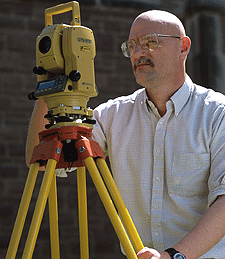The Missouri River has markedly narrowed, and its water levels have become more variable during the past 200 years, increasing flood risk. That finding by Robert E. Criss, Ph.D., professor of earth and planetary sciences in Arts & Sciences, and alumna Bethany Ehlmann (’04) was reached by interpreting centuries-old data collected by Meriwether Lewis and William Clark on their exploration of the West following the 1803 Louisiana Purchase.

Among the researchers’ findings is that the river’s width at the confluence of the Osage River has narrowed by 475 yards. Such narrowing, or channeling, was created by wing dikes and levees constructed mainly in the 20th century. Because of this, the river cannot spread out as it did naturally at the turn of the 19th century, thus forcing water levels higher, the study authors said. River narrowing also leads to greater fluctuation in day-to-day and seasonal water-level height, which might partly be to blame for declines in wetland vegetation and river wildlife, particularly shallow-water spawning fish and birds nesting on sandbars.
“The contrast is amazing if you compare graphs of river height against time taken in the 19th century versus the 20th century,” said Ehlmann, lead author and a Rhodes Scholar who completed the study for her master’s degree at Oxford University. “You’d think you were looking at two different rivers. The river today is ‘flashy’ with rapid up and down jumps in river height. But if you look at data collected by Lewis and Clark in 1804, it matches almost perfectly with the second-oldest data we have, from the 1860s.”
The quantitative data that Lewis and Clark collected is solid science that has been overlooked these 200 years, Criss said.
“Every page of their journals is full of numbers and scientific experiments,” Criss said. “They did a very fine job of measuring the river.”
At their Dubois and Fort Mandan camps, Lewis and Clark put sticks in the river each day and recorded in inches how much the river rose or fell. To measure river width, the explorers used surveying equipment, chains and compasses.
Lewis and Clark measured the Missouri River at St. Charles as 720 yards wide; contemporary U.S. Army Corps of Engineers and U.S. Geological Survey records show that the width now is just 470 yards, as noted in the paper by Criss and Ehlmann, which was published in the November issue of Geology.
Similarly, at the confluence of the Osage River and at Kansas City, Lewis and Clark measured the width of the Missouri as 875 yards and 500 yards, respectively, compared with contemporary readings of 400 yards and 330 yards, respectively.
Man-made changes to the Missouri River for irrigation, flood control and navigation began in the early 19th century, shortly after the Lewis and Clark journey. However, river discharge volume was not regularly recorded until the 1930s, long after denuding the shore of forests and river channeling with wing dikes had severely impacted the character and ecology of the river.
“No one had looked at records before the 20th century,” Ehlmann said. “So we took Lewis and Clark’s data, stage (water-level) data from government records published in the late 1800s and modern electronic stage files and did the simplest thing possible to look at the 200-year record.”
Because the stage data was recorded relative to something — and the researchers in some cases didn’t know what that something was — the pair measured change in height from day to day and change in maximum and minimum annual heights relative to the annual mean. The authors found the increased variability in both measures began around 1900, just as intensive channelization began.
“We now have a composite record for the Missouri River that’s almost three times as long as the previous one,” Criss said. “The Lewis and Clark data give us a benchmark for the natural condition. We now have a pre-development baseline for the Missouri River.”
Ehlmann sees applications for the findings in the near future. “As policy-makers balance different needs in deciding how to manage the river, we hope that this new record will aid in establishing better flood-control techniques and promoting ecosystem restoration,” she said. “Making room for the river, at least in some stretches, seems to solve both goals at the same time.”